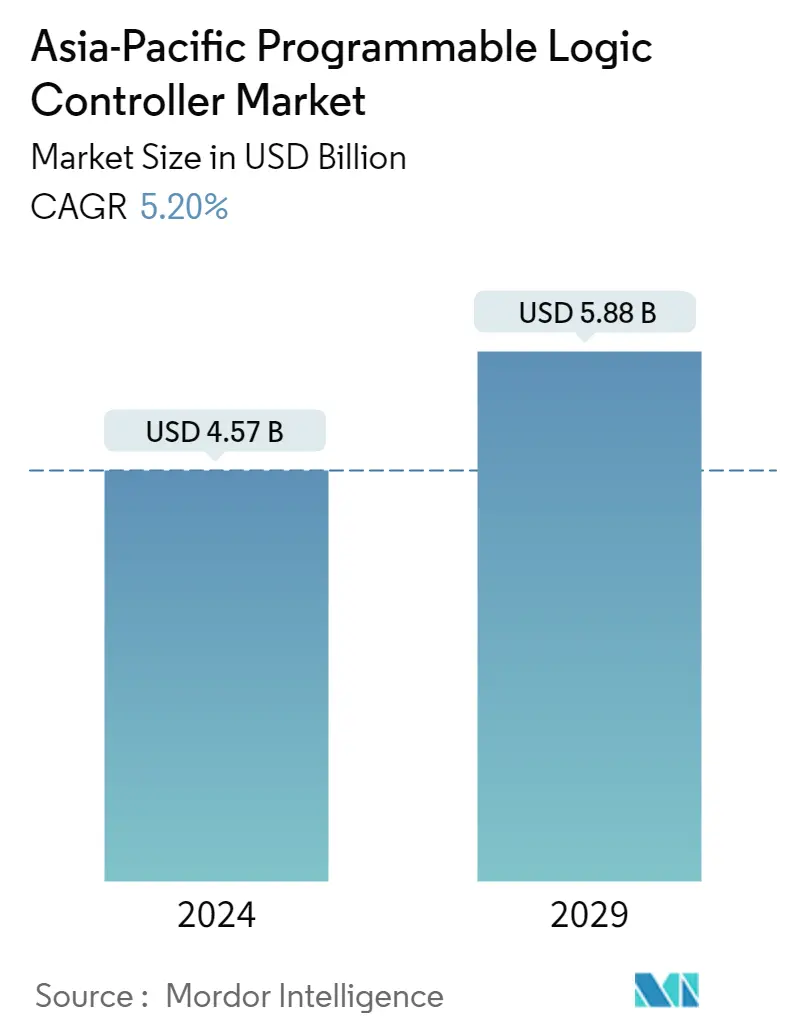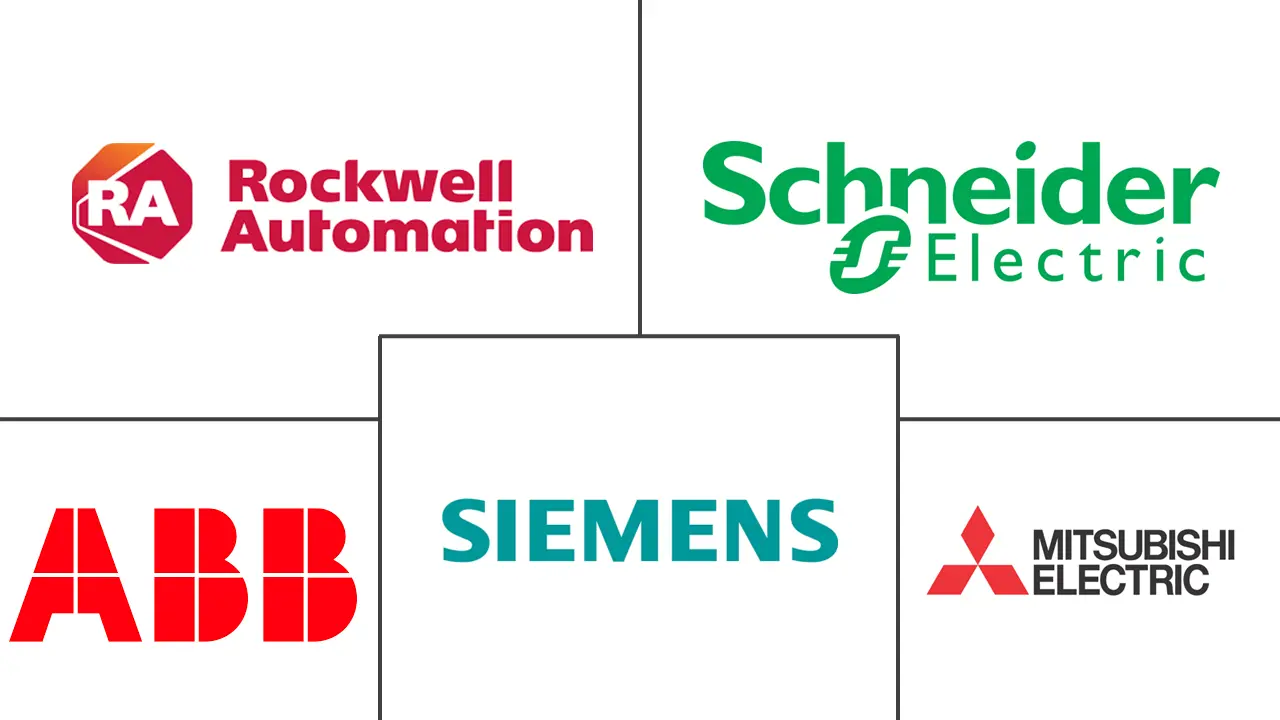Market Size of Asia-Pacific Programmable Logic Controller Industry

| Study Period | 2019 - 2029 |
| Base Year For Estimation | 2023 |
| Market Size (2024) | USD 4.57 Billion |
| Market Size (2029) | USD 5.88 Billion |
| CAGR (2024 - 2029) | 5.20 % |
| Market Concentration | Medium |
Major Players
*Disclaimer: Major Players sorted in no particular order |
APAC Programmable Logic Controller Market Analysis
The Asia-Pacific Programmable Logic Controller Market size is estimated at USD 4.57 billion in 2024, and is expected to reach USD 5.88 billion by 2029, growing at a CAGR of 5.20% during the forecast period (2024-2029).
PLC is the primary computing system that controls automated machines. The system also helps detect any errors or flaws and alerts the technician. PLC systems are also preferred over traditional systems, like relays and switch boxes, due to their compact sizes. Another advantage of PLCs is their multi-functionality, owing to their programmable nature that can be used for multiple operations depending on the application.
- PLCs are crucial to any production line, and as the fourth industrial revolution, more internet-connected sensors and systems are interfacing with PLCs. For instance, in a food and beverage manufacturing facility that produces ingredients for chocolate or baking, it is important to track all chemicals in a mixture and monitor critical events, such as a faulty boiler. In recent years it has become possible for robots to handle delicate food items directly. The arrival of new and improved gripper technology and innovative vision systems has transformed the industry. For instance, improvements in gripper technology that mimics human touch make it possible for robots to pack fruits and vegetables.
- The adoption of industrial control systems, with many businesses offering diverse solutions, has aided the market's expansion in India, defined by recent innovations. For example, Delta Electronics sells various automation products and solutions, such as human-machine interfaces, sensors, and robots. In March 2021, ABB India reported that it had attained a cumulative 5-gigawatt milestone in providing PLC-based solar plant automation in India.
- Japan intends to attain "Society 5.0" by fully leveraging the fourth industrial revolution's technology innovation, such as IoT, AI, and Big Data. To achieve this, the government established 'Connected Industries,' a new framework in which industries are expected to develop innovative solutions to societal problems by connecting many aspects of modern life, such as persons, machines, systems, and businesses. Such policies will drive the studied market.
- Due to the demand for high-voltage operating devices, Nano PLCs have also been a popular choice among discrete sectors and small businesses. Because of its simplicity of control at high voltages, fixed nano PLCs are employed in electronic applications like converters, inverters, and other base controllers. Furthermore, PLCs' ability to perform a single set of tasks with superior reliability and performance, except under real-time constraints, combined with their ability to withstand extreme temperatures, humidity, vibration, and electrical noise, has propelled PLCs' adoption in a variety of industrial applications.
- The recent coronavirus outbreak has been causing significant disruption to the global economy and has drastically changed how many industries operate daily. With work-from-home protocols implemented and shelter-in-place orders continue to propagate, allied market players evaluated and revised their preparedness and response strategies for cyber-incidents. This is particularly evident for players that have implemented industrial control systems (ICS) (PLC) to monitor and control critical equipment and processes.
APAC Programmable Logic Controller Industry Segmentation
PLC is the primary computing system that controls automated machines. The system also helps detect any errors or flaws and alerts the technician. PLC systems are also preferred over traditional systems, like relays and switch boxes, due to their compact sizes. Another advantage of PLCs is their multi-functionality (owing to their programmable nature that can be used for multiple operations depending on the application). The PLC consists of hardware, software, and services. The basic architecture of the PLC consists of main components: the processor module, the power supply, and the I/O modules.
The Asia-Pacific Programmable Logic Controller Market is Segmented by Type (Hardware and Software, Services), End-User (Food, Tobacco, and Beverage, Automotive, Chemical and Petrochemical, Energy and Utilities, pulp and paper, oil and gas, Water and Wastewater Treatment, Pharmaceutical), and country. The segmentation comprises an in-depth coverage of the revenue generated from the sale of Programmable Logic Controllers in the Asia Pacific region, along with the unit shipments.
Asia-Pacific Programmable Logic Controller Market Size Summary
The Asia-Pacific Programmable Logic Controller (PLC) market is poised for significant growth, driven by the increasing adoption of automation and smart manufacturing technologies across various industries. PLCs serve as the backbone of industrial automation, offering advantages such as compact size, multi-functionality, and the ability to control and monitor complex processes with high reliability. The market is experiencing a shift towards more advanced PLC systems that integrate with IoT, AI, and Big Data, aligning with the fourth industrial revolution. This integration is particularly evident in sectors like food and beverage, automotive, and electronics, where PLCs are used to enhance production efficiency, reduce downtime, and improve product quality. The demand for PLCs is further bolstered by government initiatives and investments in smart manufacturing and digitalization, particularly in countries like China and Japan.
The competitive landscape of the Asia-Pacific PLC market is characterized by the presence of major players such as ABB Ltd., Mitsubishi Electric Corporation, and Schneider Electric SE, who are actively investing in research and development to innovate and expand their product offerings. Collaborations, mergers, and strategic partnerships are common as companies seek to enhance their technological capabilities and market reach. The market is also witnessing the emergence of new players and startups, supported by venture capital investments, which are contributing to the dynamic growth of the sector. As industries continue to embrace automation and digital transformation, the PLC market in the Asia-Pacific region is expected to expand, driven by the need for efficient, reliable, and scalable industrial control solutions.
Asia-Pacific Programmable Logic Controller Market Size - Table of Contents
-
1. MARKET INSIGHTS
-
1.1 Market Overview
-
1.2 Industry Attractiveness - Porter's Five Forces Analysis
-
1.2.1 Bargaining Power Of Suppliers
-
1.2.2 Bargaining Power Of Buyers
-
1.2.3 Threat Of New Entrants
-
1.2.4 Threat Of Substitutes
-
1.2.5 Intensity Of Competitive Rivalry
-
-
1.3 Value Chain Analysis
-
1.4 Assessment of the Impact of Covid-19 on the Market
-
Asia-Pacific Programmable Logic Controller Market Size FAQs
How big is the Asia-Pacific Programmable Logic Controller Market?
The Asia-Pacific Programmable Logic Controller Market size is expected to reach USD 4.57 billion in 2024 and grow at a CAGR of 5.20% to reach USD 5.88 billion by 2029.
What is the current Asia-Pacific Programmable Logic Controller Market size?
In 2024, the Asia-Pacific Programmable Logic Controller Market size is expected to reach USD 4.57 billion.

